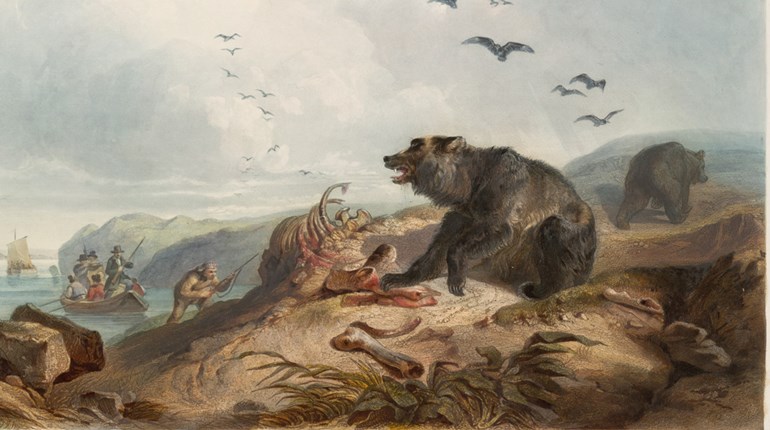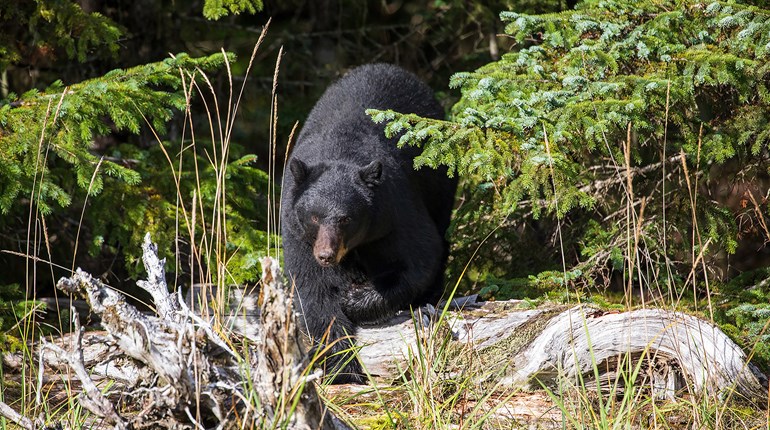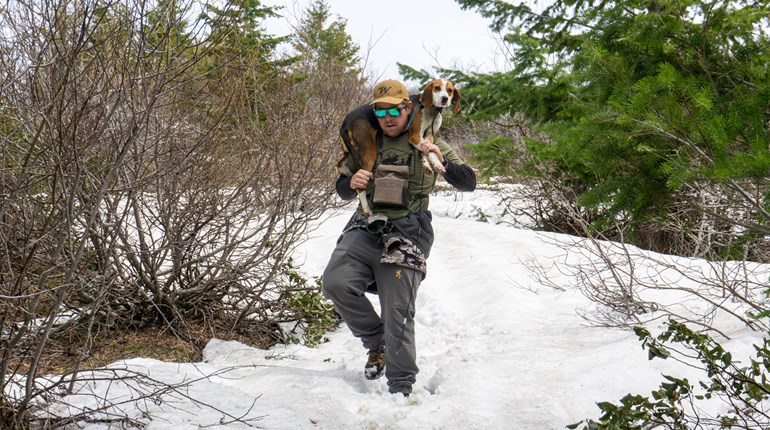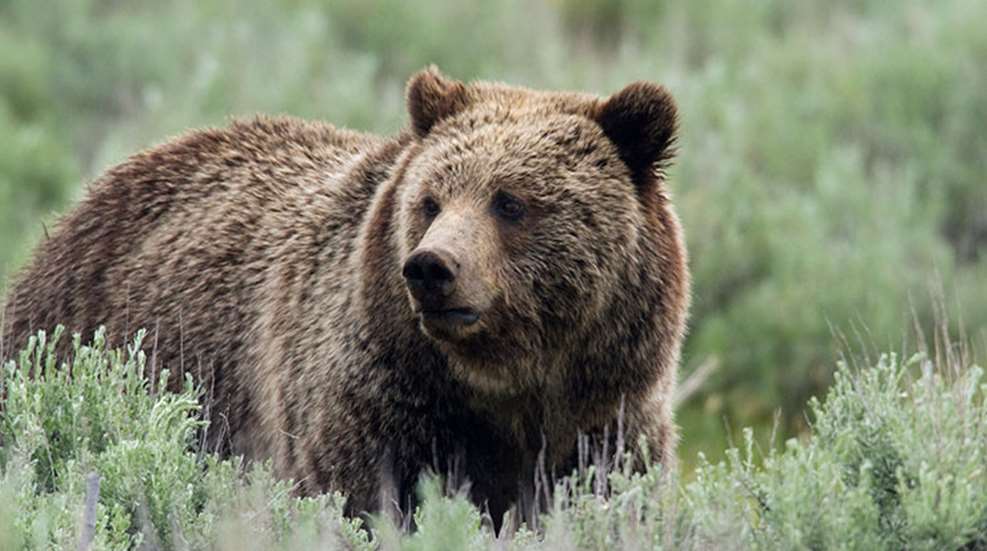
A stiff norther rippled the bear’s fur as he sauntered down the ridge to us. His coat was burnt gold, his head bigger than an oil drum and the same rusty color, his ears seemingly small and set far apart. An obvious boar, he rolled as he walked, calm and confident. This was his valley; he had probably heard my shot and understood exactly what it meant: We were on a little flat below him, boning out a good Sitka blacktail. He had answered the .30-caliber dinner bell.
Fortunately this bear had manners. We were just about to retreat when, still at a safe distance, he sat back on his haunches and let us finish. The division of work now became obvious. One cut while the other watched the bear. The boar seemed in no hurry … but we were! We made up hasty packs and exited. As we walked away, the bear strolled down the ridge as if he owned the place. Come to think of it, it was his place—and for sure he owned it!
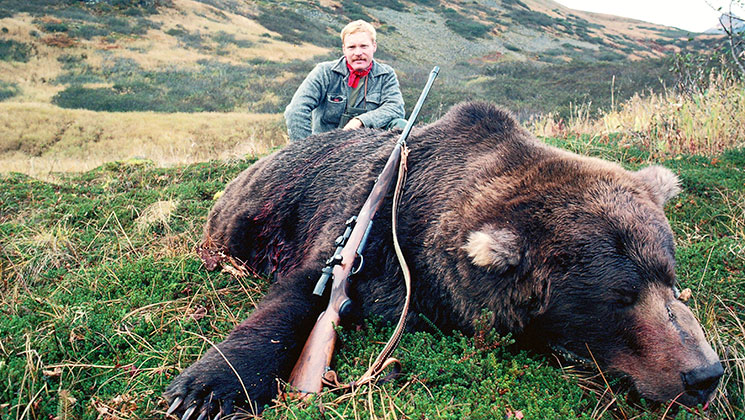
Lucky … or Not?
It is said that Theodore Roosevelt believed the grizzly bear, not the bald eagle, should be the American icon. On one level I agree: The great bear, alone and unafraid, is the ultimate symbol of wilderness and freedom. But on another level it would be presumptuous for us to lay claim, because the dish-faced, humpbacked bear nearly circumnavigates the globe in the Northern Hemisphere. Historically, tribe Ursus arctos was found from the Iberian Peninsula across Western Europe; through most of the Mideast and Asia; across the Bering Strait to Alaska and well eastward into Canada; and down the Sierras, Rockies and Great Plains into northern Mexico. There was even the Atlas grizzly in North Africa, extant in Roosevelt’s day. Distribution today is spotty in Europe but widespread in Asia, and in North America now confined to our northern Rockies, western Canada and Alaska.
Across this huge range “grizzlies” exist in numerous oft-argued subspecies, varying largely in size based on diet and hibernation period. The fish-fed bears of coastal Alaska and adjacent Siberia (and down to Japan’s northernmost islands!) are generally the largest. The bear that disputed ownership of our deer is the only “Kodiak bear” I have ever seen because that was the only time I was ever on Kodiak Island. But I have hunted these giants of the breed.
In 1981, hunting in Don Johnson’s old area on the Alaska Peninsula, I was dropped off with guide Michael Joe “just call me Slim” Gale. Appropriately, we waited out gale-force winds, so it was really our first hunting day when we saw a bear cross a meadow a couple of miles away. Slim knew his bears and I did not. He started shedding gear and I held back, arguing that we had lots of time. At 2 miles he knew what he was looking at: “Man, that’s a 10-foot bear.”
Hours later and much closer, I chanced to see the bear duck into an island of thick bush. Slim was skeptical, but after we waited for a while he circled around and gave the bear his scent. The bear came out above me and I shot him with a .375, managing to get him down before he got into the alders. Slim was wrong about that bear: The hide squared an inch shy of 11 feet. Awesome luck … or not? I wasn’t yet 30; it would be years before I appreciated that this was my very best North American game animal. Also, the hunt didn’t last long enough for me to learn much!
In the ’90s I made a couple of hunts in Southeast Alaska with Jim Keeline’s outfit. We hunted brown bear, but I was really after a glacier bear, that odd blue color phase of black bear. On the second try we saw three, a vast number, and I got one. After that I never tried for another Alaska brown bear. I’d accepted that I would never beat the one I had.
Fast forward 20 years and my wife, Donna, wanted a big bear, so we booked a boat hunt with Glacier Guides in the ABC Islands. Hunting with Alisha Rosenbruch-Decker, the plan was to get Donna a brown bear on Admiralty Island, then I’d hunt black bear farther south. At the time Alisha—nicknamed Mutts—wasn’t quite old enough to hold the coveted master guide rating, but she’d hunted bears with her dad, Jimmie Rosenbruch, since she was 9. She knows her bears, too.
Early in the hunt we took a skiff from the mother ship, intending to glass some beaches on the southwestern tip of the island. We were cruising offshore at speed when Mutts saw a tiny dark speck along a beach maybe 3 miles away. We headed in to take a look, and as she ran the boat Mutts was sharpening her knives and her eyes were gleaming. She was deadly serious.
“Oh, yes,” she said with total confidence, “that’s a really big bear. We’ll take him if we can.”
How she knew at such distance I will never understand, but she did. We beached the boat and I was relegated to boat holder while the ladies made a stalk. A rocky shelf provided a good rest and Donna made a perfect shot with a .338, dropping the bear on the beach at a bit over a hundred yards. There was no mis-call on this bear: It was a big boar, exactly 10 feet square, a great bear anywhere but exceptional for that area.
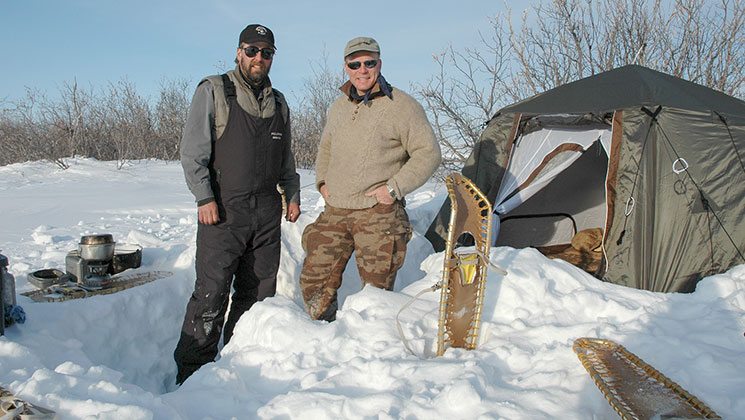
Coastal or Interior?
I suppose that ended our saga of brown bear hunting in North America. Honestly, with that kind of luck I still don’t know much about it. I’d love to have the experience again, but we can’t beat the bears we have, and the big bears are so special that it’s hard to justify.
In 1992, when Russia first opened, I hunted Siberian brown bear on the other side of the Strait. That one was a tough hunt, on skis in deep snow. As my buddy Joe Bishop, an accomplished skier, will attest, I fell down a lot! The bears were just coming out and we saw few, but at the tail end we both got very good bears. So maybe I should quit while I’m ahead!
You have to accept going in that, regardless of cost, not all hunts for big bears will be successful. Weather is a major factor, but coastal bear hunting is generally more successful than hunting interior grizzlies. Coastal bears have more reliable food sources so are more concentrated, while inland grizzlies are thinly dispersed. They don’t get as big. But I actually rate an interior grizzly as the superior animal, simply because hunting them is so much more difficult.
This bear hunting I know a bit about. When I was younger I took a couple of medium-sized grizzlies, my first clear back in 1974. Grizzly hunting is primarily a matter of painstaking glassing; in the spring you look for bears just coming out of the den, either around the den or on the first new green—or on a kill. In the fall, well, it’s just glassing, but berry patches help.
In the late ’90s I decided I wanted just one more really good interior grizzly, deciding on Arctic Alaska because of the more open country (easier glassing) and the luxurious fur. Master guide Dave Leonard was the guy, but it took us three tries! The first time we were too early, the bears just coming out when I ran out of time. The second time the thaw came too early; when the ice started to go on the river we had to get out of there. The third time was the charm: We made a grueling trek by snowshoes and found a beautiful bear on a moose kill. He was in an open bowl with ravens as sentries—we couldn’t approach too close, and a horizontal blizzard confounded the rangefinder.
I think the distance was about 250 yards, a long shot on a big bear. I also think the .325 WSM I carried was a bit light for a big bear at that distance! We got him down, no incident, but it took several shots. This, by the way, is not uncommon: Big bears don’t give up easily, and the bigger they are the harder they fall.
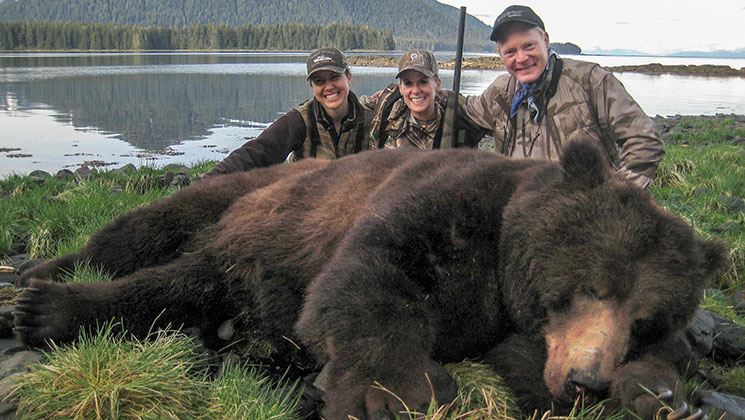
One per Customer?
At that time I decided that was my last grizzly, that I had no right to another. I’ve kept that pledge for more than a decade … but I’m not sure how I feel about it today. Certainly few will hunt them more than once, many never, and it’s not something to be done lightly. But I’ve learned it’s unwise to say “never.” Three years ago, on a fall hunt in Ron Fleming’s northern B.C. territory, we glassed the biggest grizzly I’ve ever seen, a giant of a bear. We didn’t have a bear tag so all we could do was look. But Ron saw that bear again the next year. With bear tag in my pocket I went back last fall to look for him. We didn’t find him, but if we had I’m pretty sure I’d have broken that promise.
This fall I’m backpacking into the Brooks Range with Dave Leonard, who witnessed my “last grizzly” vow. We’re hunting sheep, but I’m carrying a bear tag, so we’ll see …
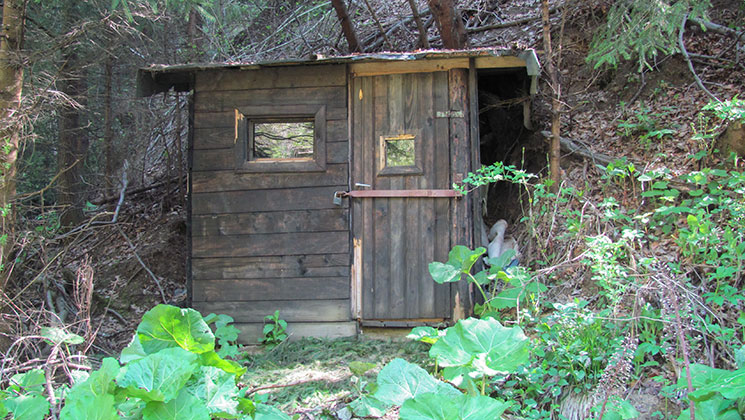
Other Big Bears
Big bears—all big bears—are fascinating, and fortunately there are other opportunities. I got really lucky on that hunt in Kamchatka, but otherwise my results in the Old World have been mixed. The European brown bear, much the same as our interior grizzly, is still hunted in several countries. I hunted this bear in Romania, which has perhaps the highest bear density in the world. In Romania everybody gets a bear, but I failed on my first attempt!
At that time, autumn, bears were coming to bait in the dark. Although unheard of over here, shooting in moonlight is legal and accepted in much of Europe. I was filming for a TV show, but while we got a good chamois (and visited Count Dracula’s castle!) the bear hunt was a bust. I tried again the next spring, but this time I left the TV camera at home. Our “blind” was a tight little cabin, complete with claw marks on the outside. And of course a beautiful bear came in before sunset, bathed in golden light.
Across the huge breadth of Eurasia there are several different subspecies of grizzlies. Another that fascinates me is the mideastern brown bear, or Syrian grizzly. I don’t think you’ll catch me hunting them in Syria, but I made my first try for one last spring in Armenia. That’s another place where there are lots of bears and everybody who wants one gets one … except, of course, me. I went in March, normally a good month, but they had the heaviest snowfall since 1971. It was still winter in bear country! We climbed every day in gorgeous mountains, but the one bear we saw gave us the slip. I hope to try that one again!
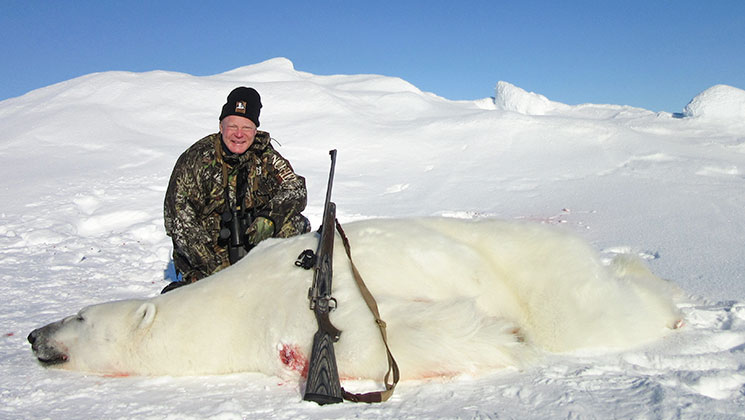
The Great White Bear
North America does have one more very big bear. Technically the polar bear isn’t a North American bear …it’s found throughout the north polar region, with populations claimed by Norway, Greenland, Russia, Canada and the United States. Canada has the largest population, over half of the world’s total; Nunavut, with 16,000 polar bears, is the only place where sport hunting is currently allowed.
Despite what you might have heard, the Canadian biologists know their polar bears are increasing. They allow a conservative harvest of about 500 bears annually, with permits doled out to First Nation villages. Those 500 bears will be harvested; polar bear hunting is traditional, and the meat is prized. The villages can utilize some of their quota for sport hunters, bringing employment and revenue. Canadian biologists credit the increase in polar bears, in part, to their sport-hunting program. Visiting hunters target older boars while native hunters prefer younger bears (better meat). Mature boars of all bear species kill cubs, but infanticide is common among polar bears. Simple: Removing older boars increases cub survival.
This was a bucket list hunt I’d wanted to do forever, but I had to think about it. I fear the cold, and politically I waited too long: I could legally take a bear, but I could not bring it home. What I could bring home was the experience, and it was unforgettable. Shane Black’s Canada North “assigned me” to Pond Inlet on the northeast coast of Baffin Island, hunting in late April 2015. Everything was still totally frozen and plenty cold, but not as brutal—and with more daylight—than earlier hunts.
The information and preparation offered was the best I’ve ever seen, but the reality is, once there and on the ice, I was totally at the mercy of my Inuit guides and the unforgiving Arctic. Fortunately I had a competent team, and Mother Nature was generous. She gave us a few days of clear weather, and surrendered a very big bear. From the village we traveled down the long inlet then south along the coast then east onto sea ice, Greenland the next landfall.
Tracks of smaller bears and sows with cubs were plentiful, and we lost one huge track in massive pressure ridges where the dog team couldn’t follow. But the reality is I shot the first and only bear I saw. As you’ve perhaps gathered, this was not unusual in my experience with big bears … and I had the same reservations. My two guides knew their business and their Arctic, but they were uncomfortable with English. This was the first polar bear I’d seen in the wild. It looked like a big boar … but was it? We had plenty of days … or did we? We were far out on the sea ice, and they’d told me a storm was coming. Ultimately I made the decision, which is how it has to be.
This bear, too, went into pressure ridges where the dogsled couldn’t go, but we’d seen him and he wasn’t afraid, just moving. With two dogs on leashes, we went in on foot, circling around to get the wind right. The bear was lying comfortably in the lee of an ice ridge when we spotted him, out of the wind and catching some pale rays.
The intent, I gathered, was to send in the dogs to distract him while we closed. But these dogs wanted no piece of this action, so we moved closer. At about 50 yards the bear saw us and got up, not just unafraid but delighted: Dinner was delivered. He swung his great head and started toward us. Now the time for second thoughts was past. Each with a sled dog on leash, neither of my guides carried a rifle. As I put the Aimpoint dot on the bear’s shoulder I hoped I’d properly degreased the Mossberg’s bolt! The red dot was bright against white fur, and the rifle fired. In a few seconds it was over, and while we tended to the skinning the pale sun went away, the wind came up and we raced a storm back toward the scant cover of the coastline. Oh yes, it was indeed a big boar, perhaps my last big bear … or perhaps not.
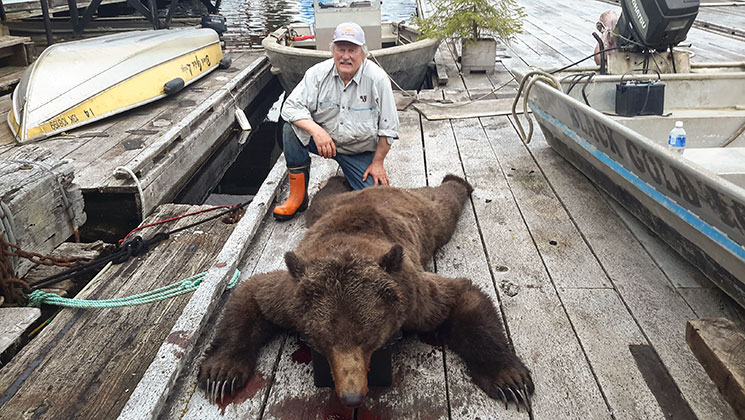
One-on-One with a B.C. Bear
The taking of a big bear, any big bear, is a magic experience in any hunter’s life. For most of us the only mar is that, by both law and common sense, a big bear must be taken on a guided hunt. Only residents where big bears also reside can have the added satisfaction of a do-it-yourself hunt. This is an experience I will never have, so I can only imagine it.
My buddy Jim Rough, a British Columbia resident, operates Black Gold fishing lodge in Rivers Inlet, up the coast from Vancouver Island. We’ve seen some awesome bears along the shoreline while fishing for salmon, and Jim always mused that, someday, he might draw a tag. In May 2017 he had the tag, mixing his bear hunting with organizing the lodge for the summer season.
Glassing from a boat, he located a couple of sows frequenting salt grass meadows. This is mating season, so he kept tabs on them, hoping a boar might come along. As circumstance dictated he was hunting alone one evening (not recommended) when a dark and beautiful boar sauntered out of the forest and joined one of the sows. Knowing he might be alone, Jim hedged his bet with his big .460 Weatherby. A quick stalk, a fast shot and faster backup shot, and he had his grizzly, truly the trophy of a lifetime, taken not only do-it-yourself but all by himself in a one-on-one encounter, rare in today’s world.












